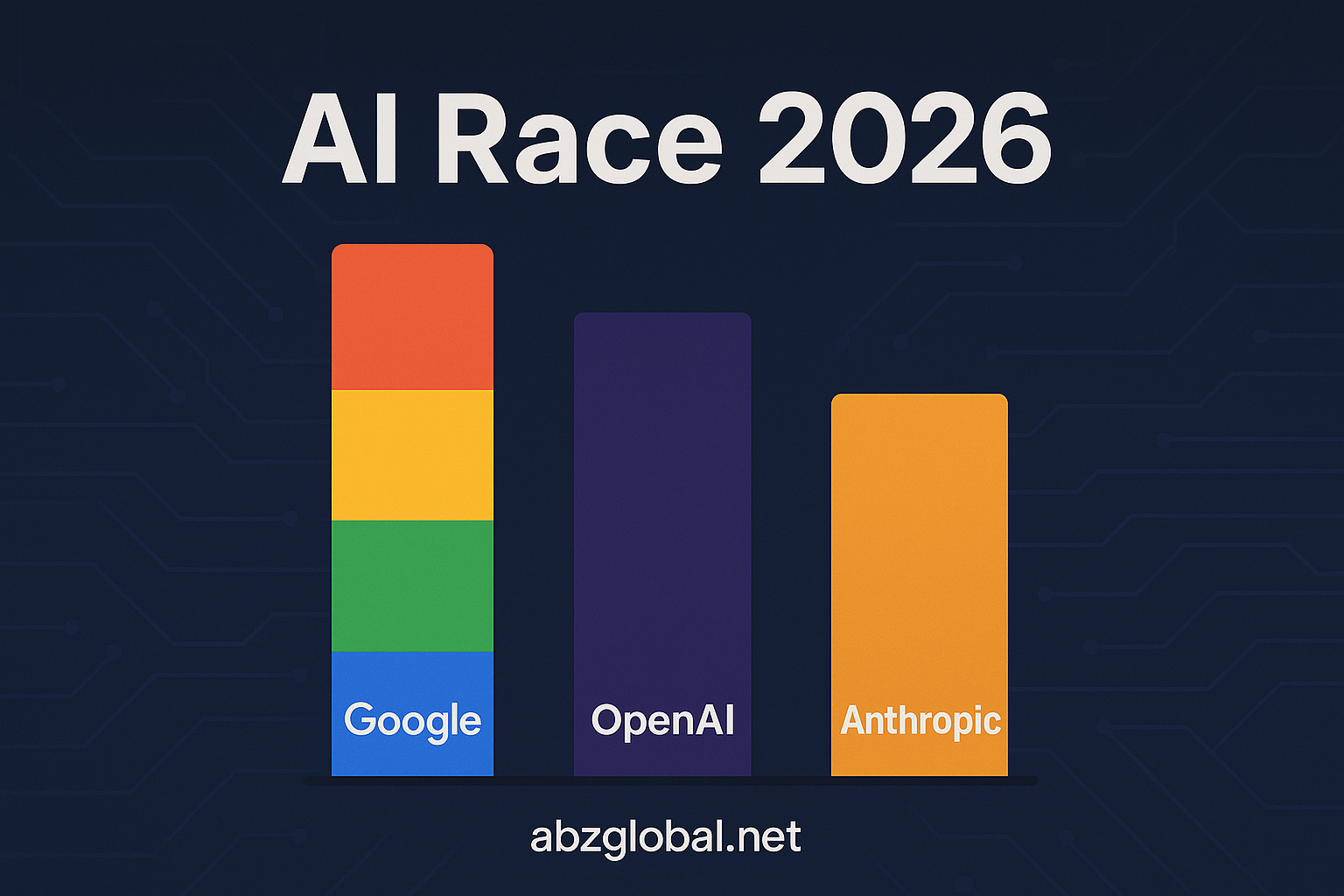My predictions for the AI race in 2026
Google
OpenAI
Anthropic
Why I put Google at #1
1) The world’s largest “knowledge graph” + web index
Google Search continuously crawls and ranks hundreds of billions of pages; its index exceeds 100,000,000 GB. That scale—and Google’s expertise in ranking and retrieval—is a real moat for training and grounding AI systems. (Google)
2) YouTube’s unmatched video corpus
YouTube is the dominant video platform with an estimated ~2.5–2.7B monthly active users in 2025. Beyond consumer reach, that means Google has extraordinary signal on what people watch, learn, and search—useful for multimodal AI (text-image-audio-video). (DemandSage)
3) Compute at hyperscale—plus Google’s own AI chips (TPUs)
Google isn’t “the only game in town,” but it is one of the three global hyperscalers (with AWS and Azure). Google Cloud is consistently #3 worldwide by market share and growing, and Google’s TPU v5e/v5p/Trillium (v6) families give it vertically integrated AI hardware that’s already widely used for training/inference. (CRN)
4) Deep AI research bench & Nobel-level impact
Google DeepMind’s Demis Hassabis and John Jumper won the 2024 Nobel Prize in Chemistry (shared with David Baker) for AlphaFold’s breakthroughs in protein structure prediction—concrete proof of frontier-class research translating into world-changing systems. (NobelPrize.org)
5) Multimodal data pipes beyond web pages
Between Google Images (massive image index tied to Search signals) and YouTube (video+audio), Google has uniquely rich, labeled multimodal data streams that can feed and evaluate generative models and agents at scale. (Google publicly documents Images support and crawling behavior; exact index counts aren’t disclosed.) (Google for Developers)
Bottom line: Google combines (a) retrieval quality, (b) video+image depth, (c) first-party AI silicon, and (d) elite research. That’s why I place it first heading into 2026.
Why OpenAI is #2 (and still terrifyingly fast)
1) Distribution & engagement
OpenAI has hundreds of millions of weekly users (recent talks put ChatGPT at ~700–800M WAU), which means rapid feedback loops, dataset flywheels, and a developer ecosystem already building atop GPTs and the API. (OpenAI)
2) Multi-vendor compute strategy at unprecedented scale
In 2024 OpenAI added Oracle Cloud Infrastructure capacity alongside Azure. In 2025 it unveiled huge GPU roadmaps with NVIDIA (aiming at 10 GW of data-center capacity) and a separate 6 GW partnership with AMD starting deployments in 2026. This diversified supply is essential for training next-gen models and agents. (Oracle)
3) Capital & valuation momentum
OpenAI’s 2025 secondary share sale reportedly valued the company around $500B, reflecting investor conviction in its revenue growth and platform position. (That’s not a “first ever,” but it is record-setting for a startup.) (Financial Times)
4) Execution DNA
OpenAI helped popularize RLHF (InstructGPT → ChatGPT), and continues iterating on reasoning and tool-use models—plus partnerships that pull more developers and enterprises into its orbit. (arXiv)
My usage note: I reach for ChatGPT most for general tasks and broad ideation; it still has the strongest “generalist” feel.
Why Anthropic rounds out the top 3
1) Distinct training philosophy that shows up in the UX
Anthropic’s Constitutional AI trains models to critique and revise their own outputs against a written “constitution” of principles—reducing the amount of direct human labeling needed and aiming for helpful, honest, harmless behavior. In practice, Claude communicates its reasoning cleanly and is excellent at code and structured editing. (Anthropic)
2) Strong coding performance (my day-to-day)
As a front-end (Angular) + Node/Firebase user, I’ve found Claude 4.5 Sonnet fast, precise, and communicative—especially on longer files and refactors. (Anecdotal, but consistent in my workflow.)
3) Big-league backers—and now massive TPU access
Amazon invested $4B (later expanded collaboration) and positions AWS as a primary partner via Bedrock. And as of Oct 2025, Anthropic and Google announced an expansion giving Anthropic access to up to one million Google TPUs (bringing well over 1 GW of compute online in 2026). That’s a leap in training capacity. (About Amazon)
Net: Different alignment methods + growing compute + sharp product focus = a durable #3, with room to surprise.
Quick fact checks & corrections
“Demis Hassabis won the 2024 Nobel Prize in Chemistry.”
Correct—Demis Hassabis and John Jumper (Google DeepMind) shared the 2024 Chemistry Nobel with David Baker. (NobelPrize.org)“OpenAI has 800M weekly users.”
Recent remarks and OpenAI posts cite ~700–800M WAU; figures fluctuate by source but clearly show massive reach. (OpenAI)“OpenAI reached a $500B valuation.”
Multiple outlets reported a ~$500B valuation via a 2025 secondary sale. (It’s record-breaking for a startup, but not meaningful to claim “first to $500B this fast” without a rigorous comparison.) (Financial Times)“Anthropic + Google: up to one million TPUs.”
Newly announced in Oct 2025—yes, access to up to 1,000,000 TPUs, with >1 GW capacity expected online in 2026. (Anthropic)
The 2026 outlook, in one line each
Google: strongest multimodal data + in-house chips + elite research → edge in foundation-model quality and agentic search. (Google)
OpenAI: unmatched product velocity + developer mindshare + multi-gigawatt GPU roadmap → edge in platform & ecosystem. (OpenAI)
Anthropic: safety-first training + excellent coding UX + newly secured TPU scale → edge in enterprise-friendly assistants and code. (Anthropic)

